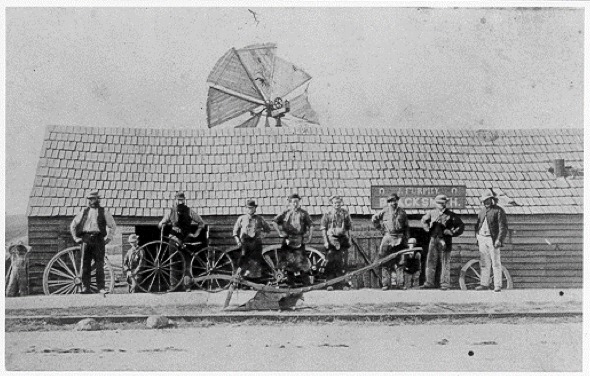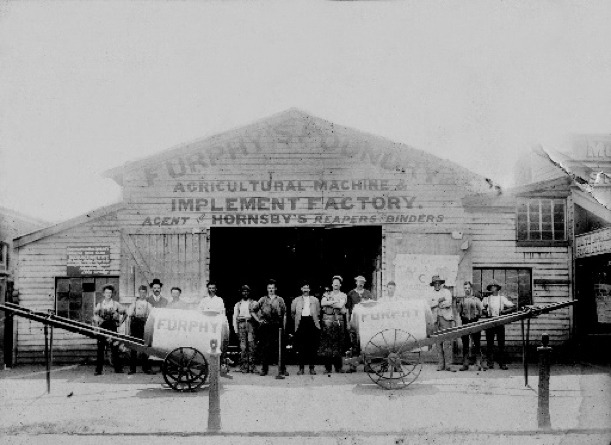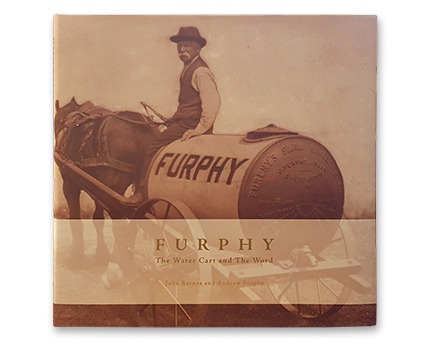The Founder
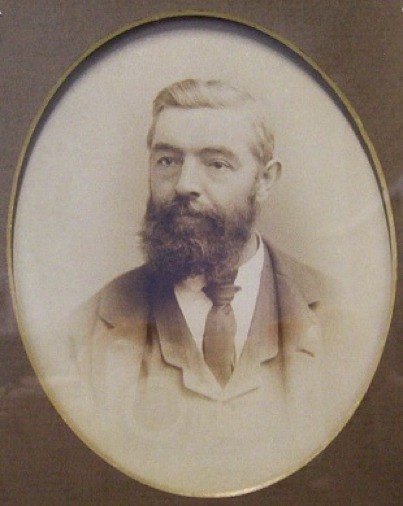 John Furphy was 22 when he began his blacksmith and wheelwright business in 1864. Born in Moonee Ponds in Melbourne in 1842 to Irish immigrant parents and subsequently raised in the Yarra Valley before the family moved to Kyneton, where he completed an apprenticeship with the firm Hutcheson and Walker, John began operations of his own in Piper St in Kyneton in Central Victoria. This began a business that would continue to flourish and carry his name over 150 years later having employed members of 4 subsequent generations of the Furphy family along with many more. The original business very much revolved around servicing the needs of the small agricultural community of Kyneton and John’s efforts met with success. John would go on to relocate his business and add a foundry to the business and inventing and producing various farm and agricultural implements including one of the most famous items of farm equipment in Australia which would lead to his name becoming part of the Australian language. In addition to this he successfully brought his sons into the partnership which began a succession that has led to this business maintaining family ownership and management today – almost 100 years after his death in 1920.
John Furphy was 22 when he began his blacksmith and wheelwright business in 1864. Born in Moonee Ponds in Melbourne in 1842 to Irish immigrant parents and subsequently raised in the Yarra Valley before the family moved to Kyneton, where he completed an apprenticeship with the firm Hutcheson and Walker, John began operations of his own in Piper St in Kyneton in Central Victoria. This began a business that would continue to flourish and carry his name over 150 years later having employed members of 4 subsequent generations of the Furphy family along with many more. The original business very much revolved around servicing the needs of the small agricultural community of Kyneton and John’s efforts met with success. John would go on to relocate his business and add a foundry to the business and inventing and producing various farm and agricultural implements including one of the most famous items of farm equipment in Australia which would lead to his name becoming part of the Australian language. In addition to this he successfully brought his sons into the partnership which began a succession that has led to this business maintaining family ownership and management today – almost 100 years after his death in 1920.
As well as being a practical and innovative man John was forthright in his views and strong in his Methodist faith. He served as a lay preacher in the Goulburn Valley district for many years delivering sermons across the district. He was involved in a number of public organisations such as the Shepparton Urban Water Trust, Agricultural Society, Free Library and Workingmen’s Club amongst others.
From Kyneton to Shepparton
From hammer and anvil to furnace and foundry.
In 1873 John heeded the call of his uncle who had taken up land in the Goulburn Valley to relocate and take advantage of the greater opportunities on offer as this area was opened up to closer settlement. It was a decision that was rewarded as the township and area around Shepparton grew rapidly in population and in production. John embodied the spirit of enterprise that was easily found in Shepparton at this time. He added a furnace to his blacksmithing and wheelwrighting operations and thus an iron foundry operation was added to the business creating a significant increase in the scope of products now able to be manufactured.
John’s particular specialisation was his ability in adaptation of machinery to suit local conditions and thereby increase the productivity of enterprise. Of particular attention was his development of the Furphy Self Raising Stripper. A device so easy to operate “- a child can manage it” read the advertisement. There were many more – swingle trees, double furrow ploughs and spike rollers. Whilst the success of these products built and in some cases diminished there was a quietly growing product that was continuing to find success – the farm water cart.
The Furphy Water Cart
 A product borne, like so many, of necessity, the Furphy Farm Water Cart provided a much needed solution for efficiently transporting water. John Furphy was the first to see the possibility of manufacturing a single item that combined water tank and a cart to transport it. With the settlement development of northern Victoria and Riverina underway and significant drought in between 1895 and 1902 the water cart quickly established itself as a vital piece of equipment.
A product borne, like so many, of necessity, the Furphy Farm Water Cart provided a much needed solution for efficiently transporting water. John Furphy was the first to see the possibility of manufacturing a single item that combined water tank and a cart to transport it. With the settlement development of northern Victoria and Riverina underway and significant drought in between 1895 and 1902 the water cart quickly established itself as a vital piece of equipment.
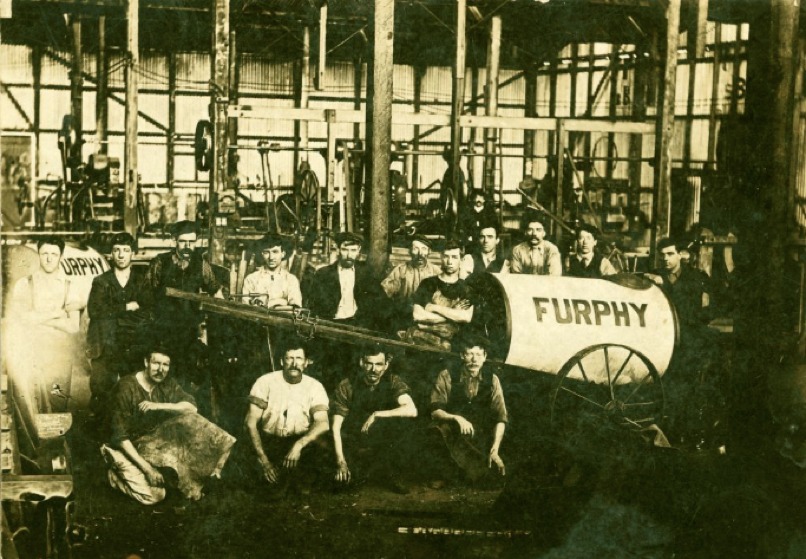 The design of the cart was simple yet effective. Cast iron concave ends were manufactured in the foundry. A rolled barrel made from galvanized iron was slipped over the ends and a ring then heated and slipped over the outside of the barrel to provide a shrink fit upon cooling. Thus the tank was water tight. Lugs cast into the ends allowed for mounting the tank on either horizontal bearers or angled shafts to accommodate fitting to a horse for transport. John painted the family name across the sides of the tanks and cast his name and more into the cast iron ends. Furphys Farm Water Cart had a number of words cast into its ends over many years. References to the foundry’s location in Shepparton as well as listings of various products also manufactured were present on the ends. But perhaps the most significant set of words to feature on the tank was the small poem encouraging continual improvement. Good Better Best, Never Let it Rest, Until your Good is Better, And your Better Best. This poem was to become synonomous with the water cart and with the company and remains the company motto today for both J. Furphy & Sons and Furphy Foundry.
The design of the cart was simple yet effective. Cast iron concave ends were manufactured in the foundry. A rolled barrel made from galvanized iron was slipped over the ends and a ring then heated and slipped over the outside of the barrel to provide a shrink fit upon cooling. Thus the tank was water tight. Lugs cast into the ends allowed for mounting the tank on either horizontal bearers or angled shafts to accommodate fitting to a horse for transport. John painted the family name across the sides of the tanks and cast his name and more into the cast iron ends. Furphys Farm Water Cart had a number of words cast into its ends over many years. References to the foundry’s location in Shepparton as well as listings of various products also manufactured were present on the ends. But perhaps the most significant set of words to feature on the tank was the small poem encouraging continual improvement. Good Better Best, Never Let it Rest, Until your Good is Better, And your Better Best. This poem was to become synonomous with the water cart and with the company and remains the company motto today for both J. Furphy & Sons and Furphy Foundry.
The War and the word
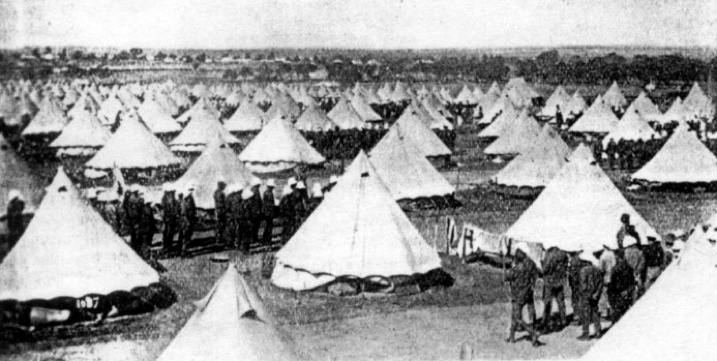 Few family names become part of the common vocabulary of a country. By the time of the first war the Furphy water cart was a relatively well known piece of equipment – in northern Victoria and the Riverina and perhaps further afield. However it was the use of Furphy Water Carts in the huge AIF camps in Broadmeadows, as troops gathered prior to being despatched across the oceans to combat, that gave the water cart it’s prominence and led to a peculiar meaning. With thousands of men camped for months a virtual city sprang up and delivery of water to troops in the camp was provided by Furphy Water Carts. As the carts would travel around the camp troops would collect water and these gatherings at the back of the Furphy became informal opportunities to share or learn information or gossip about various goings on.
Few family names become part of the common vocabulary of a country. By the time of the first war the Furphy water cart was a relatively well known piece of equipment – in northern Victoria and the Riverina and perhaps further afield. However it was the use of Furphy Water Carts in the huge AIF camps in Broadmeadows, as troops gathered prior to being despatched across the oceans to combat, that gave the water cart it’s prominence and led to a peculiar meaning. With thousands of men camped for months a virtual city sprang up and delivery of water to troops in the camp was provided by Furphy Water Carts. As the carts would travel around the camp troops would collect water and these gatherings at the back of the Furphy became informal opportunities to share or learn information or gossip about various goings on.
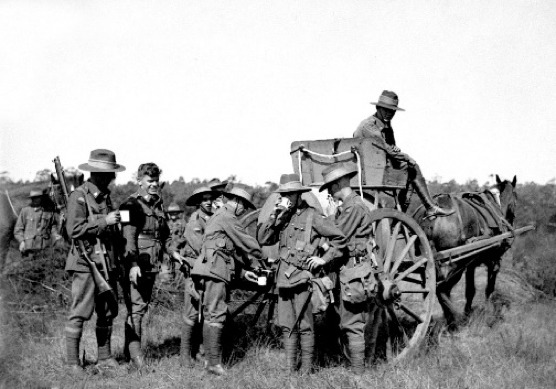 By the time the troops were in battle the water carts procured for use in the battlefields were built with no markings and became simply referred to as Furphys – such was their similarity to the carts so well known in Broadmeadows. This owed as much to the coining of the term Furphy to describe the potentially dubious nature of information gleaned from conversations around such a device as to the branding of the tanks by their manufacturer. After a number of decades as principally a soldiers word Furphy entered the broader Australian vernacular. Today its use is found principally in the political class where the term is used regularly. Fittingly there is a Furphy tank end mounted in parliament house – a gift to the parliament by Mr K. R. Ingram, former Principal Parliamentary Reporter – in honour perhaps of the importance to the reporting of parliament of the Furphy Water Cart’s unique role in Australian history.
By the time the troops were in battle the water carts procured for use in the battlefields were built with no markings and became simply referred to as Furphys – such was their similarity to the carts so well known in Broadmeadows. This owed as much to the coining of the term Furphy to describe the potentially dubious nature of information gleaned from conversations around such a device as to the branding of the tanks by their manufacturer. After a number of decades as principally a soldiers word Furphy entered the broader Australian vernacular. Today its use is found principally in the political class where the term is used regularly. Fittingly there is a Furphy tank end mounted in parliament house – a gift to the parliament by Mr K. R. Ingram, former Principal Parliamentary Reporter – in honour perhaps of the importance to the reporting of parliament of the Furphy Water Cart’s unique role in Australian history.
Joseph Furphy – Such is Life
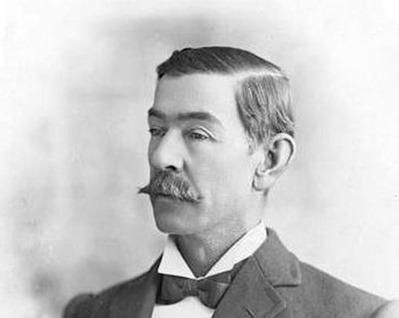 While John’s manufacturing prowess and inventiveness established the Furphy name in Australian history his brother Joseph was to make the Furphy name significant in the field of literature. After marrying at 24 and suffering a series of droughts in Corop Northern Victoria Joseph eventually established himself as a bullock driver based in Hay NSW. Alas after 5 years of this occupation drought and disease wiped out his bullock team and he subsequently returned to Shepparton where his brother offered him work in the foundry. During this time Joseph toiled by night at his novel Such Is Life – most of which he wrote in his cottage behind the foundry in Welsford St. Such is Life was a collection of stories which reflected his time in the Riverina as a bullock driver. It originally appeared in the Bulletin in 1903 and has since been recognised as a significant piece of Australian Literature. Joseph moved to Fremantle in 1904 to be nearer his three children and died there in 1912 of a brain haemorrhage. For more information about Joseph Furphy visit www.josephfurphy.com.au and to learn more about the Joseph Furphy Literature Award click here.
While John’s manufacturing prowess and inventiveness established the Furphy name in Australian history his brother Joseph was to make the Furphy name significant in the field of literature. After marrying at 24 and suffering a series of droughts in Corop Northern Victoria Joseph eventually established himself as a bullock driver based in Hay NSW. Alas after 5 years of this occupation drought and disease wiped out his bullock team and he subsequently returned to Shepparton where his brother offered him work in the foundry. During this time Joseph toiled by night at his novel Such Is Life – most of which he wrote in his cottage behind the foundry in Welsford St. Such is Life was a collection of stories which reflected his time in the Riverina as a bullock driver. It originally appeared in the Bulletin in 1903 and has since been recognised as a significant piece of Australian Literature. Joseph moved to Fremantle in 1904 to be nearer his three children and died there in 1912 of a brain haemorrhage. For more information about Joseph Furphy visit www.josephfurphy.com.au and to learn more about the Joseph Furphy Literature Award click here.
150 years and still going strong
2014 marked the 150th anniversary of continuous family business and the celebration of this milestone revolved around the launch of the Furphy Museum. Both J. Furphy & Sons and Furphy Foundry were thrilled to launch this new museum housed at the Shepparton Motor Museum. The museum features a wide collection of implements and photographs from the company’s history and allows the visitor to step back in time and trace this history.
Today the two companies that began life under John Furphy still base their operations in Shepparton and are significant employers in the town. Their combined operations include urban furniture and infrastructure, stainless steel tanks and vessels, hot dip galvanizing services and other metal fabrication. You can read more about their current day operations here

